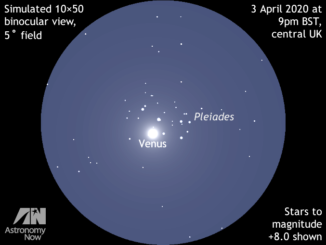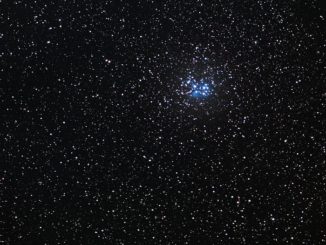
Pleiades



Get ready for Comet ATLAS (C/2019 Y4) in the northern spring sky!
Comet C/2019 Y4 was discovered by the Asteroid Terrestrial-impact Last Alert System (ATLAS) on 28 December last year and brightened 6000-fold in just two months to attain magnitude +7.5 on 1 April. Alas, the comet’s nucleus has now fragmented, dashing hopes for a conspicuous naked-eye spectacle in the constellation of Perseus. Here’s our telescopic observing guide.

Planet Venus photobombs the Pleiades (Seven Sisters) 1–5 April
As April 2020 opens, dazzling Venus at dusk is drawing ever closer to the magnificent Pleiades (Seven Sisters) in the constellation of Taurus. The brightest planet makes its closest approach to this famous open star cluster on the UK night of 3 April, when typical 10×50 binoculars and small telescopes will deliver memorable views around 9pm BST.

See the Red Planet’s encounter with the Seven Sisters at dusk
On 31 March at 4am BST, Mars passes just 3.1 degrees south of the Pleiades, or Seven Sisters open star cluster in the constellation of Taurus. The Red Planet sets before midnight as seen from the UK, so you should look to the west as darkness falls. Mars and the Pleiades lie within the same field of view of typical 10×50 binoculars from 28 March through 1 April 2019.

Catch close Comet 46P/Wirtanen near the Pleiades on 16 December
Bright Comet 46P/Wirtanen skims past Earth just 30 lunar distances away on 16 December when it could become a diffuse magnitude +3 object almost a degree wide located between the Pleiades and Aldebaran in the constellation of Taurus. Grab your binoculars and find a dark sky location well away from streetlights to enjoy this Christmas comet before the glow from a waxing Moon gets too bright from 17 December.

See the young crescent Moon meet Venus at dusk on 18 April
Observers in Western Europe should try to locate Venus low in the western sky an hour after sunset. The 3-day-old slim crescent Moon acts as a convenient guide, located some 12½ degrees (or half the span of an outstretched hand at arm’s length) to the upper left of the brightest planet on 18 April. Prominent star Aldebaran lies in the same low-power binocular field of view as the Moon too.

Kepler space telescope discovers variability in the Seven Sisters
The Seven Sisters, as they were known to the ancient Greeks, are now known to modern astronomers as the Pleiades star cluster – a set of stars which are visible to the naked eye and have been studied for thousands of years by cultures all over the world. A new algorithm to analyse data from NASA’s Kepler telescope has revealed insights about the behaviour of the stars.

See Mercury at its best in the evening sky
Mercury attains a greatest easterly elongation of 19 degrees from the Sun on 1 April. This solar separation combined with a favourable inclination of the ecliptic to the western horizon an hour after sunset, means that the period 25 March to around 8 April offers the year’s best evening showing of the innermost planet for Northern Hemisphere observers.

The Moon meets Aldebaran and the Hyades in the evening sky of 15 November
As dusk fades to dark on the evening of Tuesday 15 November, observers in the British Isles and Western Europe can see the rising 16-day-old Moon less than 2 degrees away from Aldebaran in the constellation of Taurus. While an occultation of the star occurs around 17h UT for observers in Japan, central Asia and the Middle East, skywatchers in the UK will have to settle for a near miss.
